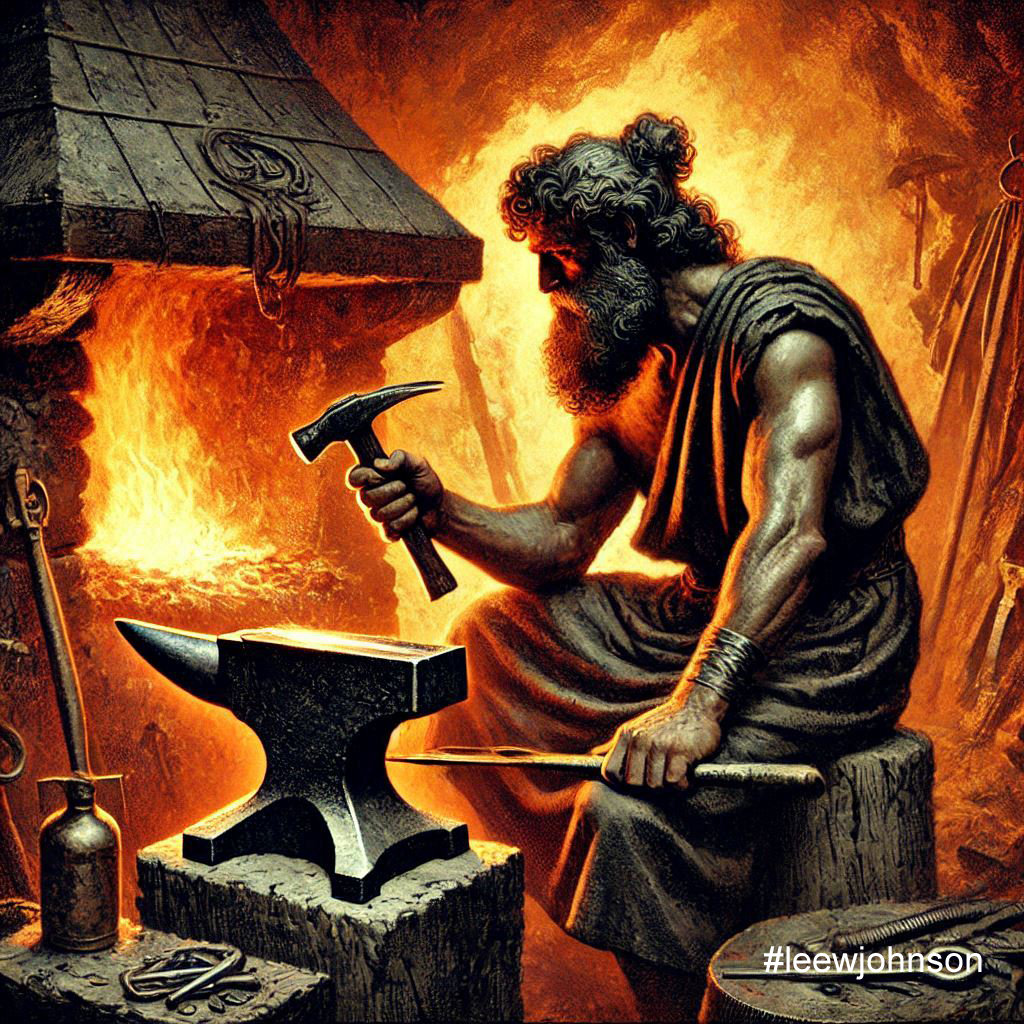Tubal Qayin

Tubal Qayin, although a prominent figure in Traditional Witchcraft, especially amongst the Cochranite Witches, is often a lesser-known figure from the Book of Genesis. Introduced in Genesis 4:22 as a “forger of all implements of bronze and iron,” Tubal Qayin is portrayed as a master craftsman, an archetypal figure linked to the birth of metallurgy and technological innovation. In Jewish, Christian, and occult traditions, he represents not only the mastery of fire and metal but also the ambiguous power of creation—the ability to shape, destroy, and transform.
Tubal Qayin: The Inheritor of a Legacy
Tubal Qayin is a descendant of Qayin (Cain). His name explicitly ties him to his forebear, with “Tubal” possibly indicating his lineage or the perpetuation of Qayin’s legacy. While Qayin represents rebellion and wandering, Tubal Qayin embodies the practical mastery of the physical world. He is often viewed as a cultural hero, the progenitor of the metallurgical arts that have shaped human civilisation.
The tools and weapons forged by Tubal Qayin signify a double-edged gift to humanity. Metallurgy allowed for the development of agriculture, architecture, and warfare, all of which dramatically altered the trajectory of human history. In this way, Tubal Qayin represents the paradox of progress: the capacity for creation and destruction, the mingling of innovation with moral ambiguity.
This aspect of the blacksmith also ties in with the myths surrounding the Grigori or The Watchers, specifically Azazel. Tubal Qayin is said to have been the avatar for Azazel, and it was the Angel himself that taught humans how to blacksmith.
The Alchemy of Tubal Qayin
In esoteric traditions, Tubal Qayin is often associated with alchemy, the mystical art of transformation. His role as a smith aligns him with the archetype of the divine craftsman, a figure found in various mythologies. The Greek Hephaestus, the Roman Vulcan, and the Canaanite Kothar-wa-Khasis are all deities or demigods linked to metallurgy and the transformative power of fire. Tubal Qayin, as the biblical forger, carries this archetype into the Abrahamic tradition.
The forge is a potent symbol in alchemy and esotericism. It represents the crucible where base materials are transmuted into something greater, a process mirroring the spiritual journey of refinement and enlightenment. Tubal Qayin’s mastery of fire and metal can thus be understood as an allegory for the spiritual work of transformation—turning the raw and chaotic elements of life into something ordered and purposeful.
Some occult interpretations view Tubal Qayin as a Luciferian figure, one who brings forbidden knowledge to humanity. In this light, his metallurgical skills are akin to the “fire” stolen by Prometheus or the knowledge offered by the serpent in Eden. Tubal Qayin’s gifts are not inherently good or evil; rather, they depend on the intentions and choices of those who wield them. This neutrality reflects the core of many esoteric teachings, which emphasise that power and knowledge are tools to be used wisely.
The Sacred Smith: Tubal Qayin in Kabbalistic and Occult Thought
In Kabbalistic tradition, Tubal Qayin is sometimes linked to the sefirah of Gevurah, the aspect of divine strength and discipline. Gevurah represents the power to create boundaries and impose order, qualities essential for the forging process. The association with Gevurah also highlights the potential for destruction, reminding us of the delicate balance between creation and annihilation.
In the Hermetic and Luciferian traditions, Tubal Qayin is often revered as a patron of artisans, alchemists, and those who seek to transform both the material and spiritual realms. His name has been used in occult circles as a symbol of the transformative power of fire and the mysteries of creation. Tubal Qayin is seen not only as a historical or mythological figure but as an archetype of the initiate, one who delves into the depths of the unknown to bring forth new understanding.
Modern interpretations often link Tubal Qayin to the concept of the “sacred smith” who embodies both creation and destruction. The smith’s work—melting, hammering, and reshaping—is a metaphor for the spiritual path, where one must endure trials and challenges to achieve refinement. The fire of the forge becomes a symbol of purification, burning away impurities to reveal the essence of the soul.
Tubal Qayin and the Shadow of Violence
Though Tubal Qayin is primarily associated with creation, his connection to his ancestor Qayin (Cain) ties him to the shadow of violence. The tools he forges can be used for cultivation or destruction, for building societies or waging war. This duality reflects the ambivalence of human ingenuity: every advancement carries the potential for both benefit and harm.
In this sense, Tubal Qayin represents the ethical dilemmas that come with progress. His story invites reflection on the responsibilities of creators and innovators. How should the gifts of knowledge and power be used? What are the consequences of misusing the tools of creation? These questions remain as relevant today as they were in the ancient world, underscoring the enduring significance of Tubal Qayin’s narrative.
Conclusion: The Enduring Myth of Tubal Qayin
Tubal Qayin is a figure who transcends his biblical origins, embodying the dualities of creation and destruction, progress and peril, knowledge and power. His story resonates across cultures and spiritual traditions, reminding us of the transformative potential of fire—both literal and metaphorical. As the archetypal smith, Tubal Qayin stands at the crossroads of innovation and morality, challenging us to consider the consequences of our actions and the legacy we leave behind. In the forge of Tubal Qayin, we find a reflection of ourselves: creators and destroyers, seekers and wanderers, ever striving to shape our lives and our world. His myth invites us to embrace the fire of transformation, to wield it wisely, and to honour the sacred balance between making and unmaking.